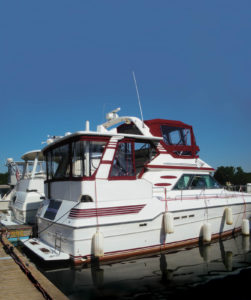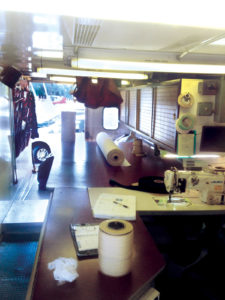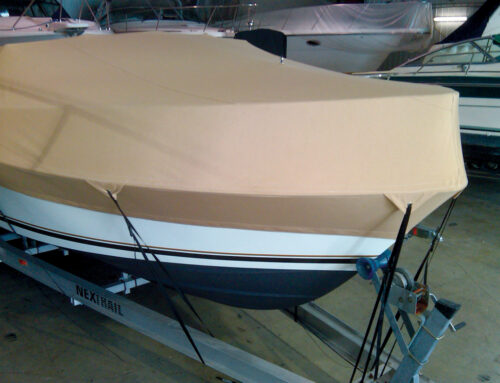On-site repair work on the rise

Fabricators have seen growth in on-site repair work and see it as more than just a trend. Moving large boats from the marina to a shop can be prohibitively expensive, and many small shops don’t have room for a large vessel. Shop owners have also seen a greater willingness among owners of smaller boats to pay for mobile service, as well.
When John Kissel of Kissel Boat Cover, North Olmsted, Ohio, steps onto a marina to do on-site boat cover work, he does so quietly. “I keep a low profile,” Kissel says. “When boat owners see me there, I’m inundated with work.”
An improving economy and a taste for convenience are driving on-site and mobile boat cover patterning work, according to Kissel. Boat cover repair companies across the country are enjoying more work these days, and a good slice of it is taking place at marinas. The convenience of on-site repair is attractive to a wide array of customers, especially those who don’t have the time or ability to take their boat into a shop.
Darrell Turner of Rayco Canvas in Harville, Ohio, and Charlie and Marcia Kees of Mister Sew-N-Sew Custom Boat Canvas in Halfmoon, N.Y., agree.
“We’ll almost always pick up other jobs while we’re at the marina.” says Turner. “We now have a following of customers who know we do mobile service. They refer us to other boat owners and provide us with repeat business.”
“While I’m at the marina, I have a nice uniform with our company logo on it. I get noticed. It’s part of how I advertise. That and word-of-mouth,” says Charlie Kees. “When other boat owners see me at the marina doing on-site work, they want my number. I often pick up a zipper or window-replacement job whenever I go on-site for a different customer.”
All three companies have seen growth in on-site repair work and see it as more than just a trend. Moving large boats from the marina to a shop can be prohibitively expensive, and many small shops don’t have room for a large vessel. Both Kissel and Turner have seen a greater willingness among owners of smaller boats to pay for mobile service, as well.
“I believe [on-site work] will take over,” Kissel says, “but not yet.”
Should I stay or should I go?
While performing patterning work on-site isn’t a new development in the boat-cover industry, it is gaining popularity. Marine Fabricators Association members are responding to the demand in different ways. Some members, like Turner, have a mobile shop they drive to jobs. “Most of our boat-cover jobs are done completely on-site,” he says. “In addition to our shop where customers can bring their boats to us for service, we have a big mobile unit—a van with a 22-foot box on it.”

Darrell Turner’s Rayco Canvas van is a mobile shop that contains a generator, air-conditioning units and sewing machines for on-site repair work.
Turner’s mobile shop includes a generator, air-conditioning units and sewing machines. He has the capability to use shore power if available, and can even make custom stainless-steel cover frames on-site on-demand. “Most of the boats we work on are larger boats and cost a lot of money to get to the shop,” he says. “These big boats that we’re doing in the water couldn’t even make it to the shop, so we make the pattern and repair it right on the spot so we don’t have to go back and forth.”
Not every company that does on-site work has a fully equipped mobile shop. Many marine fabricators offer a semi-mobile service. A shop owner or employee will travel to a boat, take pattern measurements, and then take the information back to the shop where the actual repair work is done. The new or repaired cover then goes back to the marina for final fitting and installation. The Kees travel between their shop and local marinas for regional on-site work.
“Not too many [boat canvas repair companies] are mobile or semi-mobile,” says Charlie Kees. “I think you will find that most marine fabricators do a combination of work, on any particular job, both on-site and in their shop. I don’t have a trailer or truck as a second shop that has a sewing machine in it. I would need electricity and would have to pay a marina extra just to plug in. It’s an investment, and I chose not to do it that way. [After taking a pattern on-site], I’ll go back and install it and make sure it fits. Gasoline is deductible, so I drive.”
Kissel has taken a similar approach for the past 40 years. Taking material to the marina, patterning it there and then taking it back to his shop has proven the most cost-effective method for him when performing on-site work. “I do it the old-fashioned way: I’ll find out how much material I need, sew it at my shop, clamp it back onto the frame at the marina, and that’s how I do it. I do boat covers, cockpit covers, curtains, zippers, windows, you name it,” he explains. “It’s just not cost-effective for me to have a second mobile shop.”
Others, like Turner, actively advertise on their websites that they offer fully mobile service. Rayco Canvas has been offering full on-site service for 35 years since it opened in 1978.
Price point
Whether a company maintains a mobile shop or travels between its business and local marinas, mobile boat-cover repair services cost more for the customer. Such factors as the price of fuel, maintaining extra equipment and performing jobs with quick turnaround all affect pricing. “You want to go to the marina because that’s where the money is at,” says Kissel. “Bigger boats at marinas let you get your top dollar by giving customers the best of the best. I do cockpit covers, curtains, zippers, windows, etc.”
Charlie Kees is saddled with marina fees during many of his on-site repairs. His repair contracts include the added surcharge, passed on to the boat owner.

The interior of Darrell Turner’s Rayco Canvas van is set up to provide a complete range of fabrication services wherever a customer’s boat might reside.
“The trend I’m finding is that more of the older canvas people are avoiding the hassle of surcharges at marinas by not offering mobile service,” Kees says. “I’m willing to do on-site repair, but if I have to go to a marina, it will cost more.”
Marina fees seem to be irregular or regional phenomenon, as Kissel says marina fees have been a rarity in his experience. “Ninety-nine percent of marinas don’t charge for me to go there for work,” he says. “I provide a convenient service for their customers.”
Turner’s entirely mobile shop gives him greater diversity in the kinds of jobs he can do and speeds up his turnaround on projects. Equipped with sewing machines, lighting, cutting tables, air conditioning, the capacity for frame building and an entire set of mobile tools, the Rayco Canvas van is a completely self-sustaining shop. Turner won’t fire up the van for just any job, though. “We can’t just run out and put a zipper in,” he says. “It helps if the customer will meet me somewhere in between.”
Keeping busy
On-site, semi-mobile and mobile patterning service is here to stay and will likely grow in years to come. Some companies, like Rayco Canvas, have already made it the lion’s share of their business.
“We’ve worked the whole lake front of Lake Erie doing mobile service jobs,” Turner says. “On-site work has been steadily booked out six to eight weeks all the time. We’ve been especially busy because people with the smaller boats have more money this year. We do all types of boat enclosures constantly, and we are always trying to upgrade our quality with the latest products from zipper stops to fittings and everything in between. Marine Fabricator is what keeps us in touch with how we can best serve our customers.”
While many boat-cover repair companies are adapting to the growing demand for on-site services, the additional time and effort it takes to provide them does add more work for shop owners.
Kissel puts it best when he says, “I’m happy to go on-site to do patterning and canvas repairs. But if business is good, I’d rather have the boat come to me.”
Jake Kulju is a freelance writer from Minneapolis, Minn.
 TEXTILES.ORG
TEXTILES.ORG 






